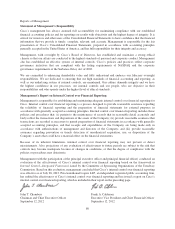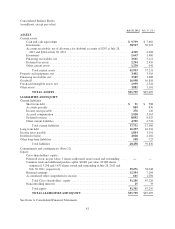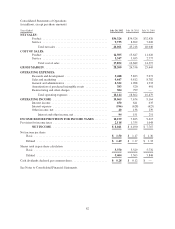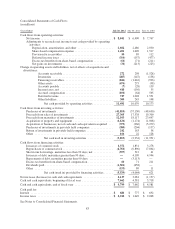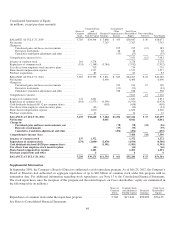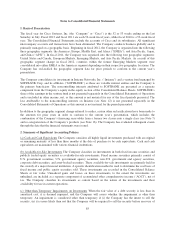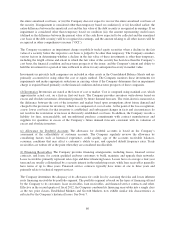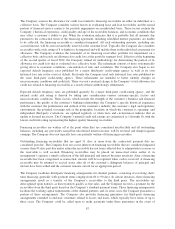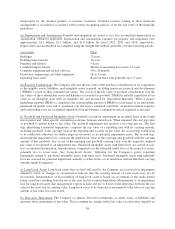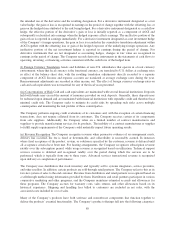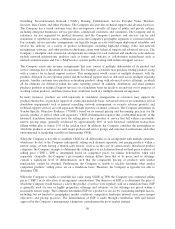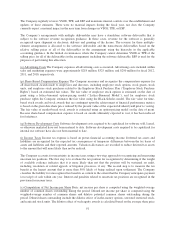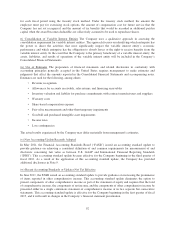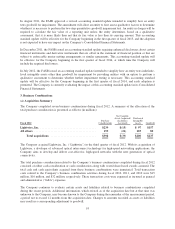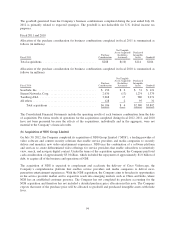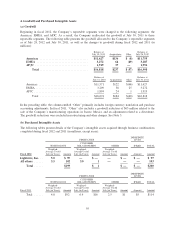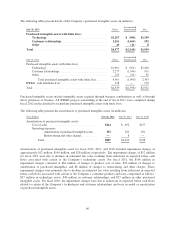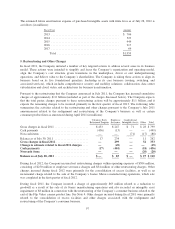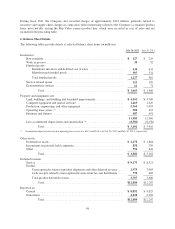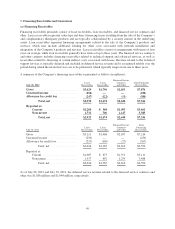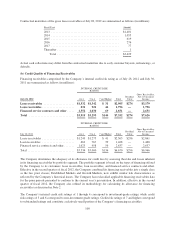Cisco 2012 Annual Report Download - page 98
Download and view the complete annual report
Please find page 98 of the 2012 Cisco annual report below. You can navigate through the pages in the report by either clicking on the pages listed below, or by using the keyword search tool below to find specific information within the annual report.Switching, Next-Generation Network (“NGN”) Routing, Collaboration, Service Provider Video, Wireless,
Security, Data Center, and Other Products. The Company also provides technical support and advanced services.
The Company has a broad customer base that encompasses virtually all types of public and private entities,
including enterprise businesses, service providers, commercial customers, and consumers. The Company and its
salesforce are not organized by product divisions, and the Company’s products and services can be sold
standalone or together in various combinations across the Company’s geographic segments or customer markets.
For example, service provider arrangements are typically larger in scale with longer deployment schedules and
involve the delivery of a variety of product technologies, including high-end routing, video and network
management software, and other product technologies along with technical support and advanced services. The
Company’s enterprise and commercial arrangements are unique for each customer and smaller in scale and may
include network infrastructure products such as routers and switches or collaboration technologies such as
unified communications and Cisco TelePresence systems products along with technical support services.
The Company enters into revenue arrangements that may consist of multiple deliverables of its product and
service offerings due to the needs of its customers. For example, a customer may purchase routing products along
with a contract for technical support services. This arrangement would consist of multiple elements, with the
products delivered in one reporting period and the technical support services delivered across multiple reporting
periods. Another customer may purchase networking products along with advanced service offerings, in which
all the elements are delivered within the same reporting period. In addition, distributors and retail partners
purchase products or technical support services on a standalone basis for resale to an end user or for purposes of
stocking certain products, and these transactions would not result in a multiple-element arrangement.
In many instances, products are sold separately in standalone arrangements as customers may support the
products themselves or purchase support on a time-and-materials basis. Advanced services are sometimes sold in
standalone engagements such as general consulting, network management, or security advisory projects, and
technical support services are sold separately through renewals of annual contracts. The Company determines its
Vendor-Specific Objective Evidence (“VSOE”) based on its normal pricing and discounting practices for the
specific product or service when sold separately. VSOE determination requires that a substantial majority of the
historical standalone transactions have the selling prices for a product or service that fall within a reasonably
narrow pricing range, generally evidenced by approximately 80% of such historical standalone transactions
falling within plus or minus 15% of the median rates. In addition, the Company considers the geographies in
which the products or services are sold, major product and service groups and customer classifications, and other
environmental or marketing variables in determining VSOE.
When the Company is not able to establish VSOE for all deliverables in an arrangement with multiple elements,
which may be due to the Company infrequently selling each element separately, not pricing products within a
narrow range, or only having a limited sales history, such as in the case of certain newly introduced product
categories, the Company attempts to determine the selling price of each element based on third-party evidence of
selling price (“TPE”). TPE is determined based on competitor prices for similar deliverables when sold
separately. Generally, the Company’s go-to-market strategy differs from that of its peers, and its offerings
contain a significant level of differentiation such that the comparable pricing of products with similar
functionality cannot be obtained. Furthermore, the Company is unable to reliably determine what similar
competitor products’ selling prices are on a standalone basis. Therefore, the Company is typically not able to
determine TPE.
When the Company is unable to establish fair value using VSOE or TPE, the Company uses estimated selling
prices (“ESP”) in its allocation of arrangement consideration. The objective of ESP is to determine the price at
which the Company would transact a sale if the product or service were regularly sold on a standalone basis. ESP
is generally used for new or highly proprietary offerings and solutions, or for offerings not priced within a
reasonably narrow range. The Company determines ESP for a product or service by considering multiple factors,
including, but not limited to, geographies, market conditions, competitive landscape, internal costs, gross margin
objectives, and pricing practices. The determination of ESP is made through consultation with and formal
approval by the Company’s management, taking into consideration the go-to-market strategy.
90


